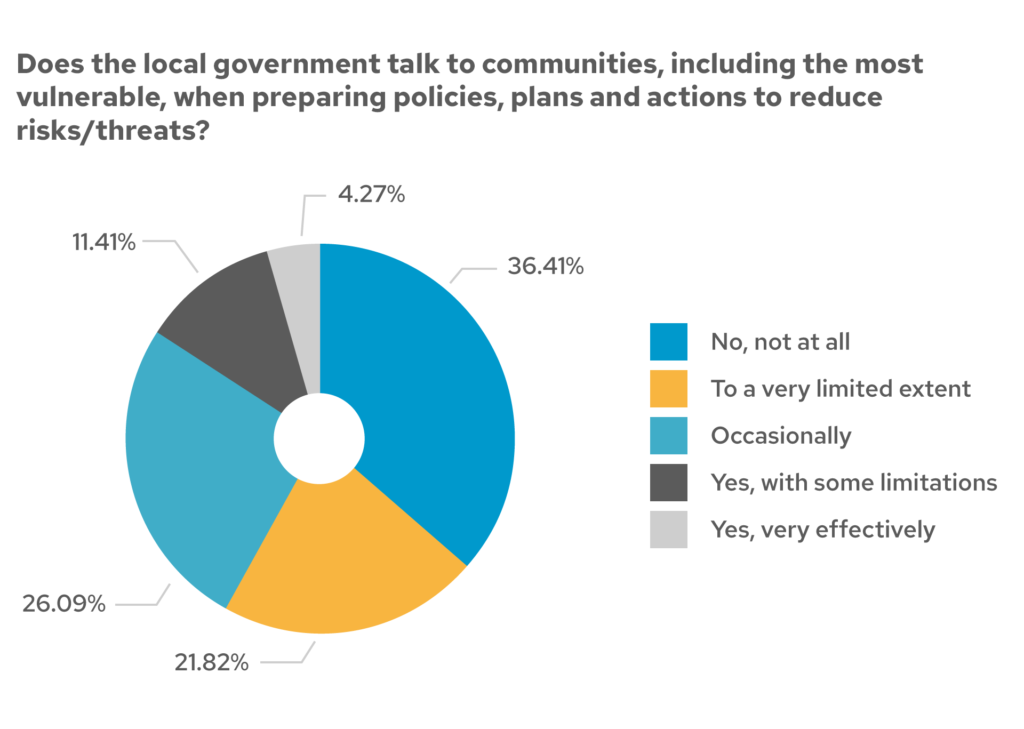VIEWS FROM THE FRONTLINE
Laos
We’re working with 15 communities in Laos to ensure that development is informed by the perspectives of people most at risk.
As part of our global Views from the Frontline programme we have surveyed community members, civil society organisations and government representatives across the country. Here we present our key findings, conclusions, activities and impact.
Random household surveys
Civil society surveys
Local government surveys
Key findings and conclusions at the national level
- Disaster risk and risk reduction approaches are not readily or consistently considered in local development planning and investment projects
- There is an overall lack of access to resources from local government in addressing risks/threats, and there are some limitations to accessing the information on actions for risk reduction, especially for women
- Knowledge on the role of ecosystems in hazard protection is very low and ecosystem-based approaches are not used in community resilience-building

Surveys undertaken in Laos
Our Views from the Frontline surveys in Laos were undertaken in 2019.
Who was surveyed?
We surveyed 609 random households, 153 civil society organisations, 154 local government representatives, and undertook 75 community consultations.
Risk locations prioritised
We prioritised four risk areas:
- Moonlamok District, Champasak Province
- Bualapha District, Khammouan Province
- Phonsay District, Louangphabang Province
- Kaluem District, Xekong Province
Communities surveyed
We surveyed people from 15 communities: Wern Village; Donnangloi Village; Thakor Village; Thanong Village; Khayu Village; Saarng Village; Phanop Village; Yarwai Village; Katangsaleuang Village; Huayjia Village; Phonthong Village; Poonglat Village; Chalae Village; Hanong Village; Songkhon Village
Our impact
Activities undertaken in response to community-level findings and conclusions
- Generated community awareness on disaster preparedness and disaster risk reduction in the form of an early warning system via loudspeaker to make disaster information accessible
- Provided life-supporting equipment including life jackets, repairing of boats, roads and the roof of a school
- Demonstrated best practice on disaster management and rice husks funds to enhance food security
Impact of activities
- Community members are better informed about disaster preparedness and risk reduction
- The capacities of local government representatives, civil society organisations, and communities is strengthened to implement risk reduction plans and activities at the local level, leading to better disaster preparedness
- Demonstration of best practices will prepare communities to deal with any kind of disaster and save lives
Making schools safe against floods
Katagsaleuang is an area affected by floods, soil erosion and landslides. Over the years, flooding has caused soil erosion and landslides that damage school buildings in the community, forcing schools to close temporarily for the safety of teachers, and students.
As a solution, Laos Red Cross, a Views from the Frontline partner begun work to build erosion resistance for schools in line with the local disaster reduction action plan toward a safe environment for children, teachers, and school staff.
Together with the community, Laos Red Cross collaborated and worked with the local government who provided technical assistance on how to build primary schools that are resistant to soil erosion. Today, several schools in the Katangsaleua area are now fortified against landslides.
Our project partners in Laos
Our Views from the Frontline programme is implemented by GNDR member organisations and partners in the country.
National coordinating organisation
- Gender Development Association
Partner organisation
- Lao Red Cross
View all data from Laos
You can view all our Views from the Frontline survey data using our data dashboard. You can also learn more about our methodology for selecting at-risk areas and survey respondents.
Project funded by
European Union

Our Views from the Frontline project is funded by the European Union (EU). Content related to this project on our website was made possible by the support of the EU. All content is the sole responsibility of GNDR and does not necessarily reflect the views of the EU.
View their websitePhoto credit
Image by Annika Hering from Pixabay.